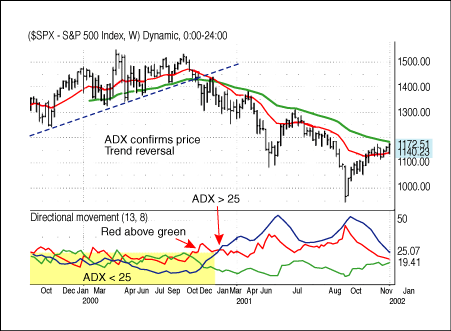Discern The Differences
ADX Reversal Patterns
When is the trend not going to continue? The average directional movement index can provide you with information you need to differentiate between the end of a trend, a consolidation, and a reversal.
Recognizing a change of trend is important for successful trading. The earlier you can enter a new trend, the lower the risk and the greater the chance for profit. Your trading will become more effective when you can recognize the end of one trend and the beginning of another.
MEASURING TREND STRENGTH
Novice traders often make judgmental statements about a stock, statements like "The stock looks good here" or "The stock is too high and ready to tank." What does "looking good" or "too high" mean? Instead of thinking with emotions, your first step in recognizing trend reversals should be to start observing. You should base your assessment of trend on objective data, not opinion.
The best indicator for assessing trend strength is average directional movement index (ADX). ADX, which can be found on most charting programs, was developed by J. Welles Wilder Jr. In my book ADXcellence, I discuss new ADX concepts and patterns, two of which I present here.
ADX quantifies trend strength, so you don't have to guess the strength of a trend or wonder when the trend will set up for a reversal; the ADX will tell you. The values for ADX range from zero to 100. An ADX value below 25 means trend strength is weak and can potentially retrace or reverse. Values over 25 mean the trend is strong and likely to continue.
ADX is based on two other indicators, the positive and negative directional movement indicators (+DMI, -DMI), which are plotted in the same indicator window as ADX. The DMI lines confirm trend direction (I say "confirm" because we always trade price, never indicators). On my charts, I color +DMI green and -DMI red. When green is above red, the trend is up; when red is above green, the trend is down. When a trend is strong with ADX above 25, keep trading in the direction of the trend until price and DMI lines cross and signal a potential change of direction.
Figure 1 is a weekly chart of the Standard & Poor's 500 at the market top in early 2000. The 20-week EMA is red and the 50-week EMA is green. The trend strength was below 25 for a period of nine months prior to the trend reversal, ample warning that the trend had weakened and might reverse at any time. When price broke out below the uptrend line, the red (-DMI) crossed above the green (+DMI), and ADX subsequently rose above 25. This indicated major new trend strength in the opposite direction.

FIGURE 1: MEASURING TREND STRENGTH. On this weekly chart of the S&P 500 you see the confirmation of the trend reversal using ADX and directional movement.
...Continued in the March issue of Technical Analysis of STOCKS
& COMMODITIES
Excerpted from an article originally published in the March 2007
issue of Technical Analysis of
STOCKS & COMMODITIES magazine. All rights reserved. © Copyright
2007, Technical Analysis, Inc.
Return to March 2007 Contents